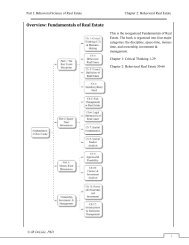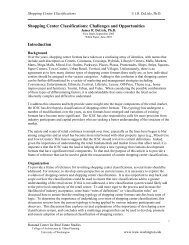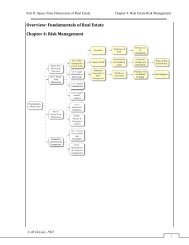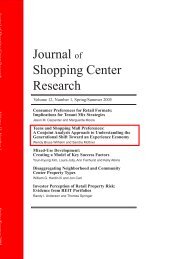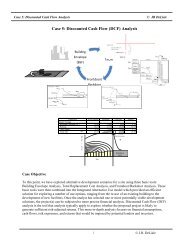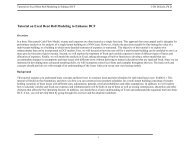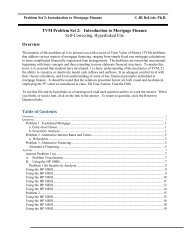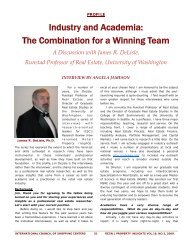TVM Tutorial - Dr. James R. DeLisle
TVM Tutorial - Dr. James R. DeLisle
TVM Tutorial - Dr. James R. DeLisle
You also want an ePaper? Increase the reach of your titles
YUMPU automatically turns print PDFs into web optimized ePapers that Google loves.
<strong>Tutorial</strong> 1: <strong>TVM</strong> and Six Functions of $1<br />
© JR <strong>DeLisle</strong><br />
Introduction to Time Value of Money (<strong>TVM</strong>)<br />
&<br />
Six Functions of $1<br />
By: <strong>James</strong> R. <strong>DeLisle</strong>, Ph.D.<br />
Revised: Fall, 2008<br />
i<br />
© JR <strong>DeLisle</strong>: Academic Use Only
<strong>Tutorial</strong> 1: <strong>TVM</strong> and Six Functions of $1<br />
© JR <strong>DeLisle</strong><br />
Table of Contents<br />
Preface.......................................................................................................................................... 1<br />
What is this Topic Doing in my Curriculum? .......................................................................... 1<br />
Why Should I Bother? ............................................................................................................. 1<br />
Introduction to <strong>TVM</strong> .................................................................................................................... 2<br />
The Money-Time Nature of Real Estate .................................................................................. 2<br />
Graphical Depiction/Visualization ........................................................................................... 3<br />
Total Nominal Cost vs. Present Value Cost............................................................................. 4<br />
Present Value Imperative ......................................................................................................... 5<br />
Simple Interest vs. Compound Interest .................................................................................... 6<br />
Mathematical Empowerment ................................................................................................... 8<br />
Analytical Intuition .................................................................................................................. 8<br />
Organization ............................................................................................................................. 9<br />
Overview of 6 Functions of $ .................................................................................................... 10<br />
Basic <strong>TVM</strong> Terminology ....................................................................................................... 10<br />
Alternative Methodologies for <strong>TVM</strong> Analysis ...................................................................... 12<br />
Graphical Representation of 6 Functions of $ ....................................................................... 12<br />
Detailed Review of 6 Functions of $1 ....................................................................................... 16<br />
FV1: Future Value of Lump .................................................................................................. 16<br />
FVA: Future Value of Annuity .............................................................................................. 19<br />
SF: Sinking Fund ................................................................................................................... 23<br />
PV1: Present Value of Lump ................................................................................................. 27<br />
PVA: Present Value of Annuity (aka PV1/P) ........................................................................ 30<br />
PR: Periodic Repayment to Amortize $1 ............................................................................... 32<br />
Conclusion ................................................................................................................................. 35<br />
ii<br />
© JR <strong>DeLisle</strong>: Academic Use Only
<strong>Tutorial</strong> 1: <strong>TVM</strong> and Six Functions of $1<br />
Preface<br />
What is this Topic Doing in my Curriculum?<br />
The typical real estate student may feel they are above the level of basic “Time Value of<br />
Money (<strong>TVM</strong>),” having magically catapulted to the world of canned spreadsheet applications<br />
or commercial discounted cash flow packages. While such tools are readily available, they<br />
cannot be validly and reliably applied without a firm understanding of the underlying<br />
mathematics of real estate finance. This caveat is based on the fact that despite the significant<br />
progress that has been made in standardizing real estate terminology and contracts as a<br />
byproduct of the emergence of the public market, that in reality, real estate remains largely an<br />
inefficient, private market in which transactions are negotiated on an individual basis.<br />
Furthermore, there are a wide variety of economic elements of real estate transactions that<br />
create an overwhelming array of combinations and permutations which can materially affect<br />
the economic viability of a particular investment. While spreadsheets and canned models can<br />
go a long way toward taking the tedium out of running a seemingly infinite array of numbers,<br />
such an approach is both inefficient and ultimately ineffective in arriving at an optimal<br />
solution.<br />
While the previous discussion might suggest that real estate financial calculations are<br />
inherently complex, the reality is that an analyst who understands the nuances of <strong>TVM</strong> can<br />
arrive at optimal decisions in an efficient manner. Furthermore, no matter who you are or what<br />
background or training you have, you can become an analyst; at least to the extent that you can<br />
master the skills necessary to model the investment performance of real estate opportunities,<br />
both residential and commercial, both individual and portfolio. As you will soon learn, an<br />
understanding of basic <strong>TVM</strong> can help you win in real estate negotiations, since the literate<br />
party can quickly and intuitively understand the nature and bottom line impact of tradeoffs that<br />
may be placed on the table during negotiations. Furthermore, you can develop an<br />
understanding for the sensitivity of returns to changes in basic assumptions, either in a<br />
particular investment profile, or in the broader economic and investment market in which such<br />
decisions are being made.<br />
Why Should I Bother?<br />
Whether you become a professional whose bread and butter depends on real estate, an investor<br />
who dabbles in real estate, or a user who buys or leases property, you will find the insights and<br />
skills conveyed in this book to be invaluable assets. This claim is especially true when<br />
juxtaposed against the alternative of blindly plugging in assumptions, hoping that they will<br />
produce the desired return or project valuation. While it might seem that mathematical<br />
calculations may be trivial and the answers obvious, the reality is that the underlying elements<br />
can take a number of gyrations that make the quantification of dependent variables extremely<br />
complicated and time consuming. You might be tempted to think that you can avoid the<br />
tedium of beginning with the basics and crunching numbers on a calculator in favor of some<br />
1<br />
© JR <strong>DeLisle</strong>: Academic Use Only
<strong>Tutorial</strong> 1: <strong>TVM</strong> and Six Functions of $1<br />
canned computers packages. If you go down this path, however, you will quickly find that<br />
such trial and error approaches are not efficient. Furthermore, they will not provide you with<br />
the ability to assess the financial risks associated with a real estate opportunity since you will<br />
not have an adequate analytical foundation upon which to model such issues. Thus, if you<br />
allow yourself to remain a naïve user blindly plugging in numbers, you will likely never<br />
develop an understanding of their interactive effects and the unanticipated linkages among<br />
them. Rather, you will be left with a confusing array of outputs that cloud the underlying<br />
economics of an investment or, even more limiting, give you a false sense of security that you<br />
have arrived at the ultimate answer. Then, when things change, as they inevitably will, you<br />
will be forced to start the random process over again, relying on luck to carry you through the<br />
uncertain future.<br />
The Money-Time Nature of Real Estate<br />
Introduction to <strong>TVM</strong><br />
By its very nature, real estate is a capital-intensive asset that has both space-time and moneytime<br />
dimensions. That is, the underlying asset includes a number of spatial elements (e.g., site,<br />
building, neighborhood, linkages) that characterize it at a certain point in time, for a certain<br />
time period. At the same time, the money-time element refers to the fact that real estate rights<br />
are typically vested for a specific period of time in return for some income or personal<br />
use/enjoyment that compensates the capital that either acquired or developed the underlying<br />
asset. The duration of these temporal elements is related to the type of control that a party<br />
exerts over the real estate, ranging from a perpetual interest that can be assigned to heirs, to a<br />
lease that creates a tenant interest for a specified term subject to the payment of a certain<br />
amount of rent. Once the magnitude and timing of cash flows can be delineated and return<br />
requirements or interest rates specified, <strong>TVM</strong> calculations can be used to determine the “value”<br />
of the transaction. Since money has a temporal dimension (e.g., $100 today is worth more than<br />
$100 in 5 years), and decision-makers are usually comparing alternative deals, Present Value<br />
(PV) is typically used to bring everything back to the current time and ensure that alternatives<br />
are compared on an “apples-to-apples” basis.<br />
2<br />
© JR <strong>DeLisle</strong>: Academic Use Only
<strong>Tutorial</strong> 1: <strong>TVM</strong> and Six Functions of $1<br />
Graphical Depiction/Visualization<br />
Given the various combinations and permutations of cash flows surrounding real estate<br />
transactions, and the number of independent items that can affect investments, one of the<br />
challenges analysts face is the ability to visualize the actual pattern of revenues and receipts.<br />
Without this intuitive understanding, it is difficult to set up problems so that they can be solved<br />
in an efficient manner. Fortunately, once the basic elements of <strong>TVM</strong> are mastered, one can<br />
easily extract the “direction” of changes in a dependent variable (e.g., rate of return, value).<br />
Exhibit 1: The Money/Time Continuum<br />
Money<br />
+<br />
-<br />
Time<br />
T = 0<br />
T = 5<br />
Illustration 1 lays out a basic graphical representation of the money/time relationship. As<br />
noted, time is represented on the horizontal or x-axis; money is represented on the vertical or y-<br />
axis. The Money axis extends from the negative to the positive, with the intersection of the<br />
Time axis establishing the “0” point. The Time axis spans from the past to the future, with the<br />
intersection of the Money axis delineating the “current time” which is also often noted T=0.<br />
The future is generally counted in terms of the number of periods from today; with T=5<br />
suggesting that it is 5 years hence.<br />
While we want to keep this initial discussion simple, it should be noted that there are two<br />
additional temporal elements that will be key in <strong>TVM</strong> calculations: periodicity, and<br />
beginning/end of period.<br />
• Periodicity. The notion of “periodicity” refers to the number of compounding periods<br />
per year. For example, a periodicity of 1 would indicate annual payments. On the other<br />
hand, a periodicity of 12 would indicate monthly payments (i.e., 12/’year).<br />
• Beginning/End of Period. The beginning/end of period notion comes into play since<br />
there can be significant differences in the value/cost of some exchange of capital<br />
depending on whether it occurs at the beginning of the period (BOP) or the end of the<br />
period (EOP). This is especially true if there is differing from the initial exchange. For<br />
3<br />
© JR <strong>DeLisle</strong>: Academic Use Only
<strong>Tutorial</strong> 1: <strong>TVM</strong> and Six Functions of $1<br />
example if you receive $1,000 at the beginning of the first year, and pay back the future<br />
value at the end of the 5 th year, you have really held onto the capital for 6 years, not 5<br />
years.<br />
• Consistency. In both periodicity and BOP/EOP calculations, the key is to keep the base<br />
consistent to support apples-to-apples comparisons. For example, if you receive 7%<br />
interest, compounded annually, for a 5 year hold you would enjoy 5 steps or earning<br />
periods in your principal plus interest calculations. On the other hand, if you received<br />
7% annual, compounded monthly, you would enjoy 60 steps or earning periods (i.e., 5<br />
* 12). On a similar note, the calculation of holding period costs/benefits should be<br />
consistent, with both inflows and outflows expressed in BOP or EOP bases; they should<br />
not be inconsistent or the number of compounding principles should be adjusted.<br />
Total Nominal Cost vs. Present Value Cost<br />
The fallacies of using nominal dollars can be illustrated with a couple of examples. Take the<br />
case of the purchase of a house that you buy for $240,000 and get a 7.5%, 30 year, fixed rate<br />
mortgage with monthly payments. On a simple level, you might think you are paying $14,440<br />
in interest (i.e., $240,000 * 80% loan to value * 7.5% interest). In reality, you will be making<br />
monthly payments of $1,341 for 360 months. If you own the house for the full term, you will<br />
be making total payments of $483,297. If you subtract the initial loan amount, that is $291,297<br />
in interest alone. If interest rates were 10%, the total payments would balloon to $606,577,<br />
with a monthly payment of $1,685, more than $344 above the 7.5% rate. This elasticity of<br />
payments, especially compared to wages which are less volatile –at least on the upside-- is one<br />
reason that homeowners can get caught with low teaser rate financing on variable rate loans.<br />
Once the loan resets, the jump in payments to the initial rates can be onerous. This situation<br />
can be further complicated if rates rise as can be expected as the cycle unfolds, their ability to<br />
pay may not keep up with interest rates.<br />
Another example can be drawn from a recent effort to defeat a monorail project in Seattle.<br />
After being narrowly approved on two occasions, when another opportunity came up to force a<br />
vote, opponents used total nominal dollars costs to exaggerate the effective cost of the project<br />
on voters. When the aggregate dollars were added up, the apparent cost was daunting, helping<br />
tip the polls toward an eventual defeat. Given the state of infrastructure and the need for<br />
deferred maintenance, it is likely such tactics will continue to be used to defeat future<br />
measures. Unfortunately, since many voters and members of the general public do not<br />
understand <strong>TVM</strong>, the risk of making sub-optimal decisions on poor economics remains.<br />
Fortunately, those of you who work your way through this material should be in a position to:<br />
1) analyze the true costs of various scenarios yourselves, 2) help educate others on the impact<br />
of <strong>TVM</strong> on decisions, and 3) develop more creative, cost-effective financial structures to<br />
achieve certain goals and objectives.<br />
4<br />
© JR <strong>DeLisle</strong>: Academic Use Only
<strong>Tutorial</strong> 1: <strong>TVM</strong> and Six Functions of $1<br />
Present Value Imperative<br />
One might question why so much emphasis is placed on Present Value; isn’t it true that dollars<br />
are dollars? While dollars are indeed relatively fungible (i.e., a dollar is a dollar is a dollar,<br />
either paper, silver or some equivalent), the value or purchasing power of a dollar varies<br />
dramatically over time. Since real estate and other investment decisions have a temporal<br />
nature (i.e., they occur or endure for some finite period), to make a correct economic or<br />
financial decision, it is critical that future outflows or inflows be expressed in present dollars.<br />
This is especially true since options often have different time periods and different risks. The<br />
only way to compensate for these differences and inherent uncertainty, is to bring the<br />
economics to a common point in time. Typically, future dollars are brought to the current or<br />
present time, although a fixed future time would be just as valid. The key in such decisions is<br />
to state the economics of various options on an “apples to apples” basis. While non-economic<br />
factors are also typically incorporated in decision making, having the economic elements<br />
expressed in clear and unambiguous terms helps the decision maker focus on other elements or<br />
criteria.<br />
5<br />
© JR <strong>DeLisle</strong>: Academic Use Only
<strong>Tutorial</strong> 1: <strong>TVM</strong> and Six Functions of $1<br />
Simple Interest vs. Compound Interest<br />
Before getting into any detailed <strong>TVM</strong> discussion, it is important to explore the differences by<br />
compound vs. simple interest since compounding is built into all <strong>TVM</strong> calculations. Consider<br />
the following example to see the differences.<br />
1 (a): Simple Interest<br />
Using simple interest, our $1,000 would earn $75/period for 5 periods. Thus, the math is<br />
relatively straightforward. Namely,<br />
Total interest = ($1,000 * 7.5%*5yr)<br />
= $375<br />
Future Value = PV + Total interest<br />
Exhibit 2: Simple Interest<br />
= $1,000 + $375<br />
= $1,375<br />
$1,000<br />
Simple Interest<br />
Σ = $375<br />
x 7.5.%<br />
=<br />
$75 $75 $75 $75<br />
$75<br />
6<br />
© JR <strong>DeLisle</strong>: Academic Use Only
<strong>Tutorial</strong> 1: <strong>TVM</strong> and Six Functions of $1<br />
1 (b): Compound Interest<br />
In the case of compound interest, we would earn interest on the interest, compounding forward<br />
to a future lump sum. Thus, the math is a little more complicated since it introduces an<br />
exponential function. Namely,<br />
Table 1 (a): Exponential Equation for Compounding FV<br />
Future Value (FV)<br />
Where:<br />
Present Value<br />
Rate<br />
Compounding Periods<br />
= PV * (1 + r) t<br />
= $1,000 * (1.075) 5<br />
= $1,000 * 1.4356294<br />
= $1,435.63<br />
PV $1,000<br />
r 7.50%<br />
t 5<br />
(Note: Annual Equation; if monthly r/12 and t*12)<br />
Note that we are keeping this example simple by looking only at annual payments so the Term<br />
(t) is the same as the number of compounding periods. In the future, we will denoted the Term<br />
as t, but the compounding periods/year will be denoted as “m.” Thus, if this example was<br />
monthly, the Compounding Periods would be 60 (i.e., 5 * 12)<br />
Table 1 (b): Tabular Example of Compounding PV<br />
Begin<br />
Interest<br />
End<br />
Balance Rate Earnings Balance<br />
1 $1,000.00 7.50% $75.00 $1,075.00<br />
2 $1,075.00 7.50% $80.63 $1,155.63<br />
3 $1,155.63 7.50% $86.67 $1,242.30<br />
4 $1,242.30 7.50% $93.17 $1,335.47<br />
5 $1,335.47 7.50% $100.16 $1,435.63<br />
As noted in Illustration 3 (b), the first $75 is added to the initial amount at the End of the<br />
period, and then earns interest at the 7.5% rate which compounds forward to $80.63. Thus, the<br />
$5.63 is the interest on the interest. That becomes the End of the period balance, and is<br />
compounded forward with the process continuing until the end of the term.<br />
7<br />
© JR <strong>DeLisle</strong>: Academic Use Only
<strong>Tutorial</strong> 1: <strong>TVM</strong> and Six Functions of $1<br />
Mathematical Empowerment<br />
Some of you may be wondering whether it is worth it to waste time playing with numbers and<br />
graphs, contending that real estate is essentially a people business in which the art of the deal<br />
dominates who does what. While the behavioral element is indeed important, the capitalintensive<br />
nature of real estate and its long-term nature quickly rise to the top of the chain in<br />
importance. Indeed, there are countless examples of real estate investors who have lost their<br />
properties and their personal wealth by underestimating the importance of solid financial<br />
analysis. On the other hand, those who have been able to amass and sustain wealth<br />
accumulation over the full real estate cycle have all learned how to manage finances for<br />
individual projects, as well as for real estate portfolios.<br />
Analytical Intuition<br />
In many respects, you have undoubtedly found out that life is a matter of timing and luck;<br />
being in the right place at the right time. This axiom carries over to real estate, although with<br />
one major caveat. Namely, one has to be able to identify a great deal and be mobilized to strike<br />
when the iron is hot. While this might seem obvious, during periods when the market is<br />
extremely active and capital is chasing deals, one can easily be confused by the various<br />
machinations and financial engineering used to make projects pencil out. Examples of such<br />
practices include: bullet-loan financing (e.g., 30 year amortization, 3 year due clause); use of<br />
subordinated or mezzanine financing at higher rates to attract more equity; participating and<br />
convertible loans to increase yields over face rates; negative amortization loans which actually<br />
grow rather than shrink in terms of outstanding balances; and, use of rent spikes in proforma<br />
cash flows to increase paper returns over hurdle rates. In addition, by incorporating more<br />
advanced techniques such as sensitivity analysis and Monte Carlo simulation, which we will<br />
introduce later, one can model the vulnerability of individual assets to various market risks and<br />
economic scenarios. Finally, when individual investments are rolled up into a “portfolio,” one<br />
can manage such risks by applying portfolio management techniques including diversification<br />
and asset allocation. Unfortunately, <strong>TVM</strong> analysis cannot avoid all such risk exposures,<br />
especially those caused by unpredictable shocks to the system. However, it can go a long way<br />
to avoiding situations that are “accidents waiting to happen.”<br />
The intellectual and mathematical range of analytical skills alluded to in the previous<br />
discussion might be daunting to a novice or one with a passing interest in real estate investing.<br />
The good news is that even the most sophisticated forms of real estate analysis can be reduced<br />
to a manageable number of <strong>TVM</strong> steps. Thus, while analyzing the previous types of problems<br />
is beyond the scope of this guide, mastering the concepts herein is a necessary condition to be<br />
able to analyze more complex problems. Without such an understanding, it would be<br />
impossible to make fundamentally sound decisions, to independently analyze the true cost of<br />
various options, select the “best option” for yourself when looking at alternatives, or evaluate<br />
the quality of financial advice you get from others. As you will note in this guide, such<br />
fundamentals are relatively straightforward in terms of using based Future Value (FV) and<br />
8<br />
© JR <strong>DeLisle</strong>: Academic Use Only
<strong>Tutorial</strong> 1: <strong>TVM</strong> and Six Functions of $1<br />
Present Value (PV) concepts. By building on this foundation, you will be able to convert future<br />
cash flows of various investment or acquisition option with different magnitudes, patterns and<br />
risks to a common denominator. This denominator can be their true Present Value, or the timeadjusted<br />
rate of return they promise if the assumptions you make are borne out. This latter form<br />
of analysis is especially important in real estate, with its long-term, capital-intensive nature.<br />
Indeed, when purchasing real estate, you are really buying a set of assumptions rather than<br />
mere bricks and mortar. As such, by being able to master basic <strong>TVM</strong> math and model<br />
alternatives, you can explore options quickly and efficiently. This ability will allow you to turn<br />
your attention to more important issues such as whether the assumptions you make in your<br />
modeling are valid and reasonable. Further, you will be able to apply sensitivity analysis to<br />
determine how stable your conclusions are relative to the various assumptions or possible<br />
changes in market conditions (e.g., increasing interest rates, slowing appreciation in housing<br />
markets) you make in your analysis. The importance of being able to conduct such analysis<br />
can be punctuated by the plight of the legions of recent homebuyers who purchased at the end<br />
of the boom cycle and turned to structured financing, as well as those who converted fixed-rate<br />
loans to adjustable rate loans to tap into home equity and lower payments at the same time.<br />
As you will note in this guide, <strong>TVM</strong> can help you convert real estate alternatives with a myriad<br />
of confusing and seemingly unrelated options from apples to oranges, to apples to apples. As<br />
such, you will be able to make an objective decision can be made on the merits of the deals<br />
rather than on a confusing set of numbers that have little meaning. You will also note that by<br />
mastering these basics and by cultivating the ability to visualize cash flows and reduce<br />
complex problems into simple, discrete components, you will be prepared to approach a range<br />
of heretofore complicated decisions from a solid analytical perspective. Ultimately, by<br />
applying various decisions models, you will be able to combine the quantitative elements of a<br />
problem with the qualitative elements, allowing you to make logical choices that have a high<br />
probability of satisfying explicit goals and objectives that you establish.<br />
Organization<br />
We have designed this workbook for you, regardless of whom you are and where you come<br />
from. Our intent is to provide you with a solid, incremental approach to the mathematics of<br />
real estate finance and investment analysis. We start with the basics, and then build up to more<br />
sophisticated concepts. To address the needs of those of you who will likely return to this<br />
material for a refresher at some point in time, or to fill in some gap in understanding some of<br />
the more subtle nuances of <strong>TVM</strong>, we have also taken care to ensure that the materials are<br />
cross-referenced and draw on the same jargon, acronyms and equations. Since learning <strong>TVM</strong> is<br />
by necessity a participatory sport, we have also compiled a number of examples that can be<br />
used as practice exercises. If you get stuck, you can refer back to the building blocks and/or<br />
visualization processes that can help fill in the missing pieces of your analysis. Welcome to<br />
the wonderful world of real estate finance!<br />
9<br />
© JR <strong>DeLisle</strong>: Academic Use Only
<strong>Tutorial</strong> 1: <strong>TVM</strong> and Six Functions of $1<br />
Basic <strong>TVM</strong> Terminology<br />
Overview of 6 Functions of $<br />
Illustration 4 provides an overview of the 6 Functions of $. As depicted, 3 functions deal with<br />
Present Value, and 3 functions deal with Future Value. The acronyms and corresponding<br />
definitions include:<br />
• Present Value. The current value of future receipts or payments.<br />
o PV1. The present value of a future lump sum (i.e., single payment) received at<br />
some finite time period assuming a stated discount rate.<br />
o PVA. The present value of a series of equal, fixed interval payments, received<br />
over some finite time period assuming a stated discount rate. This is also<br />
referred to at the PV1/P.<br />
o SF. The series of equal, fixed interval payments received over some finite time<br />
period necessary to grow to a targeted future amount earning a stated rate.<br />
• Future Value. The value of current or prior receipts or payments in the future.<br />
o FV1. The future value a present lump sum (i.e., single payment) received today<br />
will compound to over some finite time period assuming a stated rate of<br />
compounding.<br />
o FVA. The future value of a series of equal, fixed interval payments, received<br />
over some finite time period assuming a stated rate of compounding. This is<br />
also referred to as the FV1/P.<br />
o PR. The series of equal, fixed interval payments that must be made over some<br />
finite time period necessary to amortize a present value earning a stated rate.<br />
10<br />
© JR <strong>DeLisle</strong>: Academic Use Only
<strong>Tutorial</strong> 1: <strong>TVM</strong> and Six Functions of $1<br />
Exhibit 3: <strong>TVM</strong> All-in-One Six Functions of $<br />
11<br />
© JR <strong>DeLisle</strong>: Academic Use Only
<strong>Tutorial</strong> 1: <strong>TVM</strong> and Six Functions of $1<br />
Alternative Methodologies for <strong>TVM</strong> Analysis<br />
Before delving into the actual <strong>TVM</strong> calculations, it should be noted here are a variety of<br />
approaches for analyzing problems including:<br />
• Equations. Applying the actual mathematical equations using a basic calculator<br />
with exponential functions.<br />
• Financial Calculators. Using a “Financial Analyst” type calculator that has the<br />
financial functions and underlying equations preprogrammed.<br />
• Spreadsheet. Using Excel or some other spreadsheet using the raw mathematical<br />
equations or using the built-in financial functions.<br />
While each of these methodologies has advantages and disadvantages, if applied correctly, the<br />
solutions will be the same. Thus, in order to solve problems, one will have to master the chosen<br />
methodology (or be able to follow examples to plug in numbers). However, it should be noted<br />
the ability to merely plug in numbers will only work for basic problems that are presented to<br />
the analyst in a clear, unambiguous manner. While this might appear to be a reasonable<br />
expectation, in reality you will discover <strong>TVM</strong> problems –especially in real estate—are<br />
generally more complex, involving two or more <strong>TVM</strong> functions. Thus, in approaching real<br />
estate decisions, an analyst must be able to set up a problem and lay out the pattern of cash<br />
flows including nature (i.e., lump or annuity), amount, timing, and appropriate compounding or<br />
discounting rate. Thus, if you merely learn how to blindly plug numbers into a calculator or<br />
spreadsheet, you will quickly find yourself confounded by all but the most basic problems. On<br />
the other hand, understanding how to dissect a problem statement involving money and time,<br />
and set up a solution will enable you to objectively analyze the most complex problems. The<br />
balance of this guide and related cases, lecture, tutorials, and interactive problems are designed<br />
to help you cultivate this understanding. Due to the relationships among the 6 Functions of $,<br />
you will find a degree of intellectual synergy that will make learning more efficient, and more<br />
robust.<br />
Graphical Representation of 6 Functions of $<br />
To help you understand the relationships among the 6 Functions of a $, it is useful to look at a<br />
standardized set of assumptions. Exhibit 3 depicts each of the 6 Functions using a constant set<br />
of assumptions regarding amounts, rates, and timing which consist of:<br />
• Amount . $1,000 for Lump or $200 spread over 5 payments for Annuity (i.e., $1,000/5)<br />
• Term. 5 years<br />
• Periodicity. Annual<br />
12<br />
© JR <strong>DeLisle</strong>: Academic Use Only
<strong>Tutorial</strong> 1: <strong>TVM</strong> and Six Functions of $1<br />
Exhibit 4 (a): Graphical Representation of 6 Functions of $<br />
FV1<br />
$1,436<br />
PV1<br />
$1,000<br />
$1,000<br />
Reciprocals<br />
$697<br />
Future Value of $1Lum p P V<br />
Present Value of $1 Lump F V<br />
FV1/P<br />
$1,161<br />
$809<br />
PV1/P<br />
$200/P<br />
$200/P<br />
Future Value of $1/Period<br />
Present Value of $1/Period<br />
Reciprocals<br />
Reciprocals<br />
SF<br />
$1,000 $1,000<br />
PR<br />
$172/P<br />
$247/P<br />
Sinking F und to G row to $1<br />
Periodic R epaym ent to Amortize $1<br />
It should also be noted that some of the problems are reciprocals (e.g., FV1-PV1, FV1/P-SF,<br />
and PV1/P-PR). This will be important when you are using Excel to solve problems as the<br />
basic functions will used in multiple application.<br />
13<br />
© JR <strong>DeLisle</strong>: Academic Use Only
<strong>Tutorial</strong> 1: <strong>TVM</strong> and Six Functions of $1<br />
Exhibit 4 (b): Narrative Snapshot of 6 Functions of $<br />
FV1: Future Value of Lump<br />
The FV1 asks the basic question, “What will<br />
$1 invested today grow to if it earns interest at<br />
some stated rate over some finite time period?”<br />
In order to use the function, substitute the<br />
current $’s in the place of the $1, and specify<br />
the Rate and Time.<br />
FV1/P: Future Value of Fixed Payments<br />
(aka FVA: Future Value of Annuity)<br />
The FVA asks the question, “What will $1 in<br />
fixed interval payments invested each period<br />
grow to if it earns interest at some stated rate<br />
over some finite time period?” It differs from<br />
the FV1 in the sense that the amount is<br />
invested in equal amounts at fixed intervals<br />
rather than all up front in one lump sum<br />
payment.<br />
In order to use the function, substitute the<br />
actual annuitized $’s in place of the $1, and<br />
specify the Rate and Time.<br />
SF: Sinking Fund<br />
The SF asks the basic question, “What equal<br />
amount will I have to deposit each period to<br />
grow to some targeted Future Value if it earns<br />
some stated rate over some finite time period?”<br />
It differs from the other functions in that it is<br />
looking forward to earning or accruing to a<br />
targeted amount by making a series of fixed<br />
payments/deposits which are compounded<br />
forward, earning interest on the interest.<br />
In order to use the function, substitute the<br />
actual lump $’s targeted at some point in the<br />
future in place of the $1, and specify the Rate<br />
and Time.<br />
PV1: Present Value of Lump<br />
The PV1 asks the basic question, “What will $1<br />
received in the future be worth in current dollars if it<br />
erodes in value at some stated rate over some finite<br />
time period?”<br />
In order to use the function, substitute the actual $’s<br />
received in the future in the place of the $1, and<br />
specify the Rate and Time.<br />
PV1/P: Present Value of Fixed Payments<br />
(aka PVA: Present Value of Annuity)<br />
The PVA asks the question, “What will $1 received<br />
at fixed intervals receipts be worth today in terms of<br />
current dollars (i.e., purchasing power) if inflation<br />
occurs at some stated rate over a finite time period?”<br />
It differs from the PV1 in the sense that the amount<br />
being eroded is received at fixed intervals rather<br />
than all at the end of the period.<br />
In order to use the function, substitute the actual<br />
annuitized $’s in place annuitized of the $1, and<br />
specify the Rate and Time.<br />
PR: Periodic Repayment<br />
The PR asks the basic question, “If I borrow $1<br />
today, what equal amount will I have to pay each<br />
period to repay that amount plus the interest owed<br />
on the outstanding balance if I pay some stated rate<br />
over some finite time period?” It differs from the<br />
other functions in the sense that it is designed to<br />
provide a return of (i.e., repay) and a return on (i.e.,<br />
interest) over the finite period thus reducing the<br />
balance to zero. This is also known as a fixed rate,<br />
fully amortizing loan.<br />
In order to use the function, substitute the actual $’s<br />
borrowed today in place of the $1, and specify the<br />
Rate and Time.<br />
14<br />
© JR <strong>DeLisle</strong>: Academic Use Only
<strong>Tutorial</strong> 1: <strong>TVM</strong> and Six Functions of $1<br />
In this primer, we will explore a number of set-ups for the calculating the core <strong>TVM</strong> functions.<br />
In Excel, we will demonstrate the answers using two approaches: 1) prompted functions, and<br />
2) raw built-in functions. At first, you may be more comfortable using the prompts, but as you<br />
get more comfortable, you will find it much more efficient to use the raw functions. To make it<br />
easier to follow, we have named the various <strong>TVM</strong> inputs using Excel’s naming option. Exhibit<br />
4 (c) presents the names we assigned. They are also presented in the accompanying Excel file.<br />
Exhibit 4 (c): Assigned Excel Names for <strong>TVM</strong> Equations<br />
15<br />
© JR <strong>DeLisle</strong>: Academic Use Only
<strong>Tutorial</strong> 1: <strong>TVM</strong> and Six Functions of $1<br />
FV1: Future Value of Lump<br />
Detailed Review of 6 Functions of $1<br />
<strong>TVM</strong> Question. The FV1 asks the basic question, “What will $1 invested today grow to if it earns<br />
interest at some stated rate over some finite time period?” The future value of a $1 is the value of a<br />
present amount of money at some point in the future.<br />
In order to use the function in problem solving with real numbers, just substitute the current $’s in the<br />
place of the $1, and specify the Rate and Time.<br />
Exhibit 5: FV1<br />
As noted in Equation 1, the default assumption for all <strong>TVM</strong> problems, including FV1 is that<br />
the earnings are compounded forward rather than treated as simple interest. Thus, the key<br />
component of all <strong>TVM</strong> equations becomes:<br />
(1 + i) t<br />
Where :<br />
“i” stands for the interest rate; this may also be denoted “r” or “R” in some examples.<br />
“t” stands for the Term. Note the Term is adjusted for Periodicity so, if monthly, a 5<br />
year period translates to a “t” of 60 (i.e., 5 * 12).<br />
16<br />
© JR <strong>DeLisle</strong>: Academic Use Only
<strong>Tutorial</strong> 1: <strong>TVM</strong> and Six Functions of $1<br />
Table 2 (a): FV $1<br />
Future Value (FV)<br />
Where:<br />
Present Value<br />
Rate<br />
Compounding Periods<br />
= PV * (1 + r) t<br />
= $1,000 * (1.075) 5<br />
= $1,000 * 1.4356294<br />
= $1,435.63<br />
PV $1,000<br />
r 7.50%<br />
t 5<br />
(Note: Annual Equation; if monthly r/12 and t*12)<br />
Table 2 (b): FV Payment in Advance<br />
Begin<br />
Interest<br />
End<br />
Balance Rate Earnings Balance<br />
1 $1,000.00 7.50% $75.00 $1,075.00<br />
2 $1,075.00 7.50% $80.63 $1,155.63<br />
3 $1,155.63 7.50% $86.67 $1,242.30<br />
4 $1,242.30 7.50% $93.17 $1,335.47<br />
5 $1,335.47 7.50% $100.16 $1,435.63<br />
Table 2 (c): FV1 Equations for Alternative Methodologies<br />
Math<br />
Excel<br />
WebCT<br />
=+(FV_PV)*((1+(FV_i)/(FV_m)))^((FV_t)*(FV_m))<br />
=FV(FV_i/FV_m,FV_t*FV_m,0,-FV_PV)<br />
{a}*((1+({i}/100/{m}))**({t}*{m}))<br />
Table 2 (d): HP Answer to FV1<br />
Factor Code Initial Answer<br />
Compounding/Period m 1<br />
Term t 5<br />
Present Value PV $1,000<br />
Payment PMT $0.00<br />
Future Value FV $1,435.63<br />
Interest Rate I 7.50%<br />
17<br />
© JR <strong>DeLisle</strong>: Academic Use Only
<strong>Tutorial</strong> 1: <strong>TVM</strong> and Six Functions of $1<br />
Method Steps: HP 10BII<br />
• First, clear all by pressing the GOLD key and then the C ALL key.<br />
• Second, tell the HP that you want to work annually by entering 1, pressing the GOLD<br />
key, and then P/YR. (NOTE: this should stay the default from the previous until you<br />
change it; clearing the registers does not affect this default).<br />
• Third, enter 5, press the GOLD key, and then press X P/YR.<br />
• Fourth, enter 7.5, press the GOLD key, and then press Nom%.<br />
• Fifth, enter 1,000, and then press PV. Finally, press FV to solve.<br />
Exhibit 6 (a): Prompted Excel Solutions: FV1<br />
It should be noted that Excel uses the same prompts for calculating the Future Value of a dollar<br />
lump (FV1) and the Future Value of an Annuity (FVA). Within Excel, the difference is<br />
whether the input is the Pv or the Pmt. Thus, it is important to ensure that you are plugging the<br />
inputs into the correct location. In the raw function, each of the variables is delineated by a<br />
comma. Thus, it is important to ensure that you place the respective inputs in the correct<br />
locations. The good news is that Excel highlights the variables in the equation as you plug<br />
them in. Also, the =FV will return a negative number to indicate it is the outlay that<br />
corresponds to the future benefit. It can be converted to a positive by leading with =-FV. The<br />
[(type)] variable allows you to specify whether the payments are made at the beginning or end<br />
of the period; usually, they can be left blank unless the payment is does not follow the defalt or<br />
normal conventions. This is the raw FV function:<br />
Exhibit 6 (b): Raw Excel FV Function<br />
18<br />
© JR <strong>DeLisle</strong>: Academic Use Only
<strong>Tutorial</strong> 1: <strong>TVM</strong> and Six Functions of $1<br />
FVA: Future Value of Annuity<br />
(aka FV1/P: Future Value of Fixed Payment)<br />
<strong>TVM</strong> Question. The FVA asks the question, “What will $1 in fixed interval payments invested each<br />
period grow to if it earns interest at some stated rate over some finite time period?” It differs from the<br />
FV1 in the sense that the amount is invested in equal amounts at fixed intervals rather than all up front<br />
in one lump sum payment.<br />
In order to use the function, substitute the actual annuitized $’s in place of the $1, and specify the Rate<br />
and Time.<br />
Exhibit 7: FVA<br />
The future value of an annuity ($1/period) is the amount that accumulated by a series of equal<br />
payments at interest over a period of time<br />
Types of FVA Problems<br />
There are two types of FVA problems: payment in advance or at the beginning of each period;<br />
or, payment in arrears in which payments are made at the end of the period.<br />
19<br />
© JR <strong>DeLisle</strong>: Academic Use Only
<strong>Tutorial</strong> 1: <strong>TVM</strong> and Six Functions of $1<br />
FV Annuity in Advance. In the case of an annuity in advance, we would receive the first<br />
payment immediately and the rest at the beginning of each period compounding forward to a<br />
future lump sum.<br />
Table 3 (a): FV Annuity in Advance<br />
or<br />
FV = Sum [R(1+ r) n ]<br />
= $200(1.075) 5 + $200(1.075) 4<br />
+ $200(1.075) 3 + $200(1.075) 2<br />
+ $200(1.075)<br />
FV = R * [((1 + r) t - 1) (1+r))/ r]<br />
= $200*[((1.075) 5 -1)(( 1.075))/.075]<br />
= $200 * (6.2440204)<br />
= $1,248.80<br />
Where:<br />
Periodic Receipt<br />
Rate<br />
Compounding Periods<br />
R $200<br />
r 7.50%<br />
t 5<br />
(Note: Annual Equation; if monthly r/12 and t*12)<br />
Table 3 (b): Annuity in Advance Schedule<br />
Period Period Interest End<br />
Receipt Begin. Bal. Rate Earnings Balance<br />
1 $200 $200.00 7.50% $15.00 $215.00<br />
2 $200 $415.00 7.50% $31.13 $446.13<br />
3 $200 $646.13 7.50% $48.46 $694.58<br />
4 $200 $894.58 7.50% $67.09 $961.68<br />
5 $200 $1,161.68 7.50% $87.13 $1,248.80<br />
FV Annuity in Arrears. In the case of an annuity in arrears, we would receive the payments at<br />
the end of each period compounding forward to a future lump sum.<br />
Table 3 (c): FV Annuity in Arrears<br />
FV<br />
Where:<br />
Periodic Receipt<br />
Rate<br />
Compounding Periods<br />
= R * [ ((1+ r) t - 1/r)]<br />
= $200 * [((1.075) 5 - 1)/.075)]<br />
= $200 * (5.8.83911)<br />
= $1,161.68<br />
(Note: Annual Equation; if monthly r/12 and t*12)<br />
R $200<br />
r 7.50%<br />
t 5<br />
20<br />
© JR <strong>DeLisle</strong>: Academic Use Only
<strong>Tutorial</strong> 1: <strong>TVM</strong> and Six Functions of $1<br />
Table 3 (d): FV Annuity in Arrears Schedule<br />
Period Beginning Earnings per Period<br />
End Ending<br />
Balance Rate Amount Subtotal Payment Balance<br />
1 7.50% $200.00 $200.00<br />
2 $200.00 7.50% $15.00 $215.00 $200.00 $415.00<br />
3 $415.00 7.50% $31.13 $446.13 $200.00 $646.13<br />
4 $646.13 7.50% $48.46 $694.58 $200.00 $894.58<br />
5 $894.58 7.50% $67.09 $961.68 $200.00 $1,161.68<br />
Table 3 (e): FVA Equations for Alternative Methodologies<br />
Math<br />
Excel<br />
WebCT<br />
=+(FVA_PMT)*((((1+((FVA_i)/(FVA_m)))^(FVA_t*FVA_m))-<br />
1)/(FVA_i/FVA_m))<br />
=FV(FV_i/FV_m,FV_t*FV_m,,-FV_PV)<br />
{a}* (((1+({i}/100/{m}))**({t}*{m}))-1)/(({i}/100/{m}))<br />
Table 3 (f): HP Solutions 2: FVA<br />
Factor Code Initial Answer<br />
Compounding/Period m 1<br />
Term t 5<br />
Present Value PV $0<br />
Payment PMT $200<br />
Future Value FV $1,161.68<br />
Interest Rate I 7.50%<br />
Method Steps: HP 10BII<br />
• First, clear all by pressing the GOLD key and then the C ALL key.<br />
• Second, tell the HP that you want to work annually by entering 1, pressing the GOLD<br />
key, and then P/YR. (NOTE: this should stay the default from the previous until you<br />
change it; clearing the registers does not affect this default)<br />
• Third, enter 5, press the GOLD key, and then X P/YR.<br />
• Fourth, enter 7.5, press the GOLD key, and then NOM%.<br />
• Fifth, enter 200 and then press PMT<br />
• Sixth, press FV to get answer.<br />
21<br />
© JR <strong>DeLisle</strong>: Academic Use Only
<strong>Tutorial</strong> 1: <strong>TVM</strong> and Six Functions of $1<br />
Exhibit 8 (a): Prompted Excel FVA in arrears<br />
Note that Excel uses the same prompts for FV and FVA; difference is in use of Pmt vs. Pv. The<br />
default in HP10BII and Excel is to treat it as an annuity in arrears which is the typical industry<br />
practice.<br />
Exhibit 8 (b): Prompted Excel FVA in advance<br />
To change it to an Annuity in Advance, the “Type” is noted as below.<br />
22<br />
© JR <strong>DeLisle</strong>: Academic Use Only
<strong>Tutorial</strong> 1: <strong>TVM</strong> and Six Functions of $1<br />
SF: Sinking Fund<br />
<strong>TVM</strong> Question.The SF asks the basic question, “What equal amount will I have to deposit each period<br />
to grow to some targeted Future Value if it earns some stated rate over some finite time period?” It<br />
differs from the other functions in that it is looking forward to earning or accruing to a targeted amount<br />
by making a series of fixed payments/deposits which are compounded forward, earning interest on the<br />
interest.<br />
In order to use the function, substitute the actual lump $’s targeted at some point in the future in place<br />
of the $1, and specify the Rate and Time.<br />
Exhibit 9: Sinking Fund<br />
Types of SF Payments<br />
As in the case of the FVA, there are two types of SF problems: payment in advance or at the<br />
beginning of each period; or, payment in arrears in which payments are made at the end of the<br />
period. Note that the SF is the reciprocal of the FVA<br />
SF Annuity in Advance. In the case of an annuity in advance, we would receive the first<br />
payment immediately and the rest at the beginning of each period compounding forward to a<br />
future lump sum. In our case:<br />
23<br />
© JR <strong>DeLisle</strong>: Academic Use Only
<strong>Tutorial</strong> 1: <strong>TVM</strong> and Six Functions of $1<br />
Table 4 (a): SF Annuity in Advance<br />
SF<br />
= FV * [r/((1 + r) t - 1)(1+r)]<br />
= $1,000 *[.075/((1.075) 5 -1)(1.075)]<br />
= $1,000 * (.16015322)<br />
= $160.15<br />
Where:<br />
Future Value<br />
Rate<br />
Compounding Periods<br />
FV $1,000<br />
r 7.50%<br />
t 5<br />
(Note: Annual Equation; if monthly r/12 and t*12)<br />
Table 4 (b): SFAnnuity in Advance Schedule<br />
Period Period<br />
Interest<br />
End<br />
Payment Begin. Bal. Rate Earnings Balance<br />
1 $160.15 $160.15 7.50% $12.01 $172.16<br />
2 $160.15 $332.31 7.50% $24.92 $357.23<br />
3 $160.15 $517.38 7.50% $38.80 $556.19<br />
4 $160.15 $716.34 7.50% $53.73 $770.06<br />
5 $160.15 $930.21 7.50% $69.77 $1,000.0<br />
SF Annuity in Arrears. In the case of an annuity in arrears, we would receive the payments at<br />
the end of each period compounding forward to a future lump sum. In our case:<br />
Table 4 (c): SF Annuity in Arrears<br />
SF<br />
Where:<br />
Future Value<br />
Rate<br />
Compounding Periods<br />
= FV * [r/((1 + r) t - 1)]<br />
= $1,000 * [(.075/(1.-75)5 - 1)]<br />
= $1,000 * (.1721647)<br />
$172.16<br />
(Note: Annual Equation; if monthly r/12 and t*12)<br />
FV $1,000<br />
r 7.50%<br />
t 5<br />
Table 4 (d): SF Annuity in Arrears Schedule<br />
24<br />
© JR <strong>DeLisle</strong>: Academic Use Only
<strong>Tutorial</strong> 1: <strong>TVM</strong> and Six Functions of $1<br />
Period Beginning Earnings per Period<br />
End Ending<br />
Balance Rate Amount Subtotal Payment Balance<br />
1 7.50% $172.16 $172.16<br />
2 $172.16 7.50% $12.91 $185.07 $172.16 $357.23<br />
3 $357.23 7.50% $26.79 $384.02 $172.16 $556.18<br />
4 $556.18 7.50% $41.71 $597.90 $172.16 $770.06<br />
5 $770.06 7.50% $57.75 $827.81 $172.16 $1,000.0<br />
Table 4 (e) SF Annuity Equations for Alternative Methodologies<br />
Math<br />
Excel<br />
WebCT<br />
=+(SF_FV)*((SF_i/SF_m)/(((1+(SF_i)/SF_m))^(SF_t*SF_m)-1))<br />
=PMT(SF_i/SF_m,SF_t*SF_m,,-SF_FV)<br />
{a}*(({i}/100/{m})/(((1+({i}/100/{m}))**({t}*{m}))-1))<br />
Table 4 (f): HP Solution to SF<br />
Factor Code Initial Answer<br />
Compounding/Period m 1<br />
Term t 5<br />
Present Value PV $0<br />
Payment PMT $172.16<br />
Future Value FV $1,000<br />
Interest Rate I 7.50%<br />
Method Steps: HP 10BII<br />
• First, clear all by using the GOLD key and then the C ALL key.<br />
• Second, tell the HP that you want to work annually by entering 1, pressing the GOLD<br />
key, and then press P/YR. (NOTE: this should stay the default from the previous until<br />
you change it; clearing the registers does not affect this default).<br />
• Third, enter 5 and then press the GOLD key and then X P/YR.<br />
• Fourth, enter 7.5, press the GOLD key and then NOM%.<br />
• Fifth, enter 1,000 and then press FV<br />
• Sixth, press PMT to get answer.<br />
Exhibit 10 (a): Prompted Excel SF (arrears)<br />
25<br />
© JR <strong>DeLisle</strong>: Academic Use Only
<strong>Tutorial</strong> 1: <strong>TVM</strong> and Six Functions of $1<br />
Note that the SF is the reciprocal of the FVA. Excel uses the same prompts for FV and FVA;<br />
difference is in use of Pmt vs. Pv. The default in HP10BII and Excel is to treat it as an annuity<br />
in arrears which is the typical industry practice.<br />
Exhibit 10 (b): Prompted Excel SF (advance)<br />
To change the SF to an Annuity in Advance, the “Type” is noted as below. Note the payment is<br />
smaller since it will compound an additional period.<br />
26<br />
© JR <strong>DeLisle</strong>: Academic Use Only
<strong>Tutorial</strong> 1: <strong>TVM</strong> and Six Functions of $1<br />
PV1: Present Value of Lump<br />
<strong>TVM</strong> Question.The PV1 asks the basic question, “What will $1 received in the future be worth in<br />
current dollars if it erodes in value at some stated rate over some finite time period?”<br />
In order to use the function, substitute the actual $’s received in the future in the place of the $1, and<br />
specify the Rate and Time.<br />
Exhibit 11: PV1<br />
Table 5 (a): Equation for PV1<br />
PV = FV/ (1+r) t<br />
Where:<br />
Future Value<br />
Rate<br />
Compounding Periods<br />
= $1,000/ (1.075) 5<br />
= $1,000/1.4356294<br />
$696.56<br />
FV $1,000<br />
r 7.50%<br />
t 5<br />
(Note: Annual Equation; if monthly r/12 and t*12)<br />
27<br />
© JR <strong>DeLisle</strong>: Academic Use Only
<strong>Tutorial</strong> 1: <strong>TVM</strong> and Six Functions of $1<br />
Table 5 (b): PV1 Schedule<br />
Period Begin Interest<br />
End<br />
Balance Rate Earnings Balance<br />
1 $696.56 7.50% $52.24 $748.80<br />
2 $748.80 7.50% $56.16 $804.96<br />
3 $804.96 7.50% $60.37 $865.33<br />
4 $865.33 7.50% $64.90 $930.23<br />
5 $930.23 7.50% $69.77 $1,000.00<br />
Table 5 (c): PV1 Equations for Alternative Methodologies<br />
Math<br />
Excel<br />
WebCT<br />
=+(PV_FV)*((1/((1+(PV_i/PV_m))^(PV_t*PV_m))))<br />
=PV(PV_i/PV_m,PV_t*PV_m,,-PV_FV)<br />
{a}*(1/((1+({I}/100/{m}))**({t}*{m})))<br />
Table 5 (d): HP Solution for PV1<br />
Factor Code Initial Answer<br />
Compounding/Period m 1<br />
Term t 5<br />
Present Value PV $696.56<br />
Payment PMT $0.00<br />
Future Value FV $1,000<br />
Interest Rate I 7.50%<br />
Method Steps: HP 10BII<br />
• First, clear all by pressing the GOLD key and then the C ALL key.<br />
• Second, tell the HP that you want to work annually by entering 1, pressing the GOLD<br />
key, and then P/YR. (NOTE: this should stay the default from the previous until you<br />
change it; clearing the registers does not affect this default).<br />
• Third, enter 5, press the GOLD key, and then X P/YR.<br />
• Fourth, enter 7.5, press the GOLD key, and then NOM%.<br />
• Fifth, enter 1,000 and then press FV<br />
28<br />
© JR <strong>DeLisle</strong>: Academic Use Only
<strong>Tutorial</strong> 1: <strong>TVM</strong> and Six Functions of $1<br />
• Sixth, press PV to get answer.<br />
Exhibit 12: Prompted Excel PV1<br />
Note both HP10B and Excel assume the receipt is at the “END” of the Term and is brought<br />
back to today, the beginning point.<br />
29<br />
© JR <strong>DeLisle</strong>: Academic Use Only
<strong>Tutorial</strong> 1: <strong>TVM</strong> and Six Functions of $1<br />
PVA: Present Value of Annuity (aka PV1/P)<br />
<strong>TVM</strong> Question..The PVA asks the question, “What will $1 received at fixed intervals receipts be worth<br />
today in terms of current dollars (i.e., purchasing power) if inflation occurs at some stated rate over a<br />
finite time period?” It differs from the PV1 in the sense that the amount being eroded is received at<br />
fixed intervals rather than all at the end of the period.<br />
In order to use the function, substitute the actual annuitized $’s in place annuitized of the $1, and<br />
specify the Rate and Time.<br />
Exhibit 12: Present Value Annuity PVA<br />
PV Annuity in Arrears. In the case of PV Annuity problems, the default assumption is<br />
payments in arrears.<br />
Table 6 (a): PV Annuity in Arrears<br />
PV = R * [((1 - (1/(1 + r) t ))/r]<br />
= $200 * [(1 - (1/(1.075) 5 ))/.075]<br />
= $200 * [(1 - .6965586)/.075)]<br />
= $200 * (4.0458849)<br />
= $809.18<br />
Where:<br />
Periodic Receipt R $200<br />
Rate<br />
r 7.50%<br />
Compounding Periods t 5<br />
(Note: Annual Equation; if monthly r/12 and t*12)<br />
30<br />
© JR <strong>DeLisle</strong>: Academic Use Only
<strong>Tutorial</strong> 1: <strong>TVM</strong> and Six Functions of $1<br />
Table 6 (b): PVA Equations for Alternative Methodologies<br />
Math<br />
Excel<br />
WebCT<br />
=+(PVA_PMT)*((1-(1/((1+(PVA_i/PVA_m))^(PVA_t*PVA_m)))))/(PVA_i/PVA_m)<br />
=PV(PVA_i/PVA_m,PVA_t*PVA_m,-PVA_PMT)<br />
{a}*(1-(1/(1+({i}/100)/{m})**({t}*{m})))/(({i}/100)/{m})<br />
Table 6 (c): HP Solution to PVA<br />
Factor Code Initial Answer<br />
Compounding/Period m 1<br />
Term t 5<br />
Present Value PV $809.18<br />
Payment PMT $200<br />
Future Value FV $0<br />
Interest Rate I 7.50%<br />
Method Steps: HP 10BII<br />
• First, clear all by pressing the GOLD key and then the C ALL key.<br />
• Second, tell the HP that you want to work annually by entering 1, pressing the GOLD<br />
key, and then the P/YR. (NOTE: this should stay the default from the previous until you<br />
change it; clearing the registers does not affect this default)<br />
• Third, enter 5, press the GOLD key, and then X P/YR<br />
• Fourth, enter 7.5, press the GOLD key, and then NOM%.<br />
• Fifth, enter 200 and then press PMT<br />
• Sixth, press PV to get answer<br />
31<br />
© JR <strong>DeLisle</strong>: Academic Use Only
<strong>Tutorial</strong> 1: <strong>TVM</strong> and Six Functions of $1<br />
Exhibit 13 (a): Prompted Excel PVA in arrears<br />
Note the difference between End and Beginning of Period (i.e., arrears or advance). The<br />
default is in arrears. In this case, the treatment of timing is material in this example since the<br />
periodicity is annual and the term is short. If it was monthly and longer term, the differences<br />
would typically be immaterial.<br />
Exhibit 13 (b): Prompted PVA in advance<br />
PR: Periodic Repayment to Amortize $1<br />
32<br />
© JR <strong>DeLisle</strong>: Academic Use Only
<strong>Tutorial</strong> 1: <strong>TVM</strong> and Six Functions of $1<br />
<strong>TVM</strong> Question. The PR asks the basic question, “If I borrow $1 today, what equal amount will I have<br />
to pay each period to repay that amount plus the interest owed on the outstanding balance if I pay some<br />
stated rate over some finite time period?” It differs from the other functions in the sense that it is<br />
designed to provide a return of (i.e., repay) and a return on (i.e., interest) over the finite period thus<br />
reducing the balance to zero. This is also known as a fixed rate, fully amortizing loan.<br />
In order to use the function, substitute the actual $’s borrowed today in place of the $1, and specify the<br />
Rate and Time.<br />
Exhibit 14: Periodic Payment (aka Periodic Repayment PR)<br />
In the case of Periodic Repayment problems, the default assumption is payments in arrears.<br />
Table 7 (a): PR in Arrears<br />
PR = PV * [r/((1 - (1/(1 + r) t ))]<br />
= $1,000 * [.075/(1 - (1/(1.075) 5 ))]<br />
= $1,000 * [.075/(1 - .6965586)]<br />
= $1,000 * (.2471647)<br />
= $247.16<br />
Where:<br />
Present Value PV $1,000<br />
Rate<br />
r 7.50%<br />
Compounding Periods t 5<br />
(Note: Annual Equation; if monthly r/12 and t*12)<br />
33<br />
© JR <strong>DeLisle</strong>: Academic Use Only
<strong>Tutorial</strong> 1: <strong>TVM</strong> and Six Functions of $1<br />
Table 7 (b): PR Equations for Alternative Methodologies<br />
Math<br />
Excel<br />
WebCT<br />
=+(PR_PV)*((PR_i/PR_m)/((1-(1/((1+(PR_i/PR_m))^(PR_t*PR_m))))))<br />
=PMT(PR_i/PR_m,PR_t*PR_m,-PR_PV)<br />
{a}*(({i}/100)/{m})/(1-(1/(1+({i}/100)/{m})**({t}*{m})))<br />
Table 7 (c): HP Solution for PR<br />
Factor Code Initial Answer<br />
Compounding/Period m 1<br />
Term t 5<br />
Present Value PV $1,000<br />
Payment PMT $247.16<br />
Future Value FV $0<br />
Interest Rate I 7.50%<br />
Method Steps: HP 10BII<br />
• First, clear all by pressing the GOLD key and then the C ALL key.<br />
• Second, tell the HP that you want to work annually by entering 1 and then pressing the<br />
GOLD key followed by the P/YR. (NOTE: this should stay the default from the<br />
previous until you change it; clearing the registers does not affect this default).<br />
• Third, enter 5, press the GOLD key, and then press X P/YR.<br />
• Fourth, enter 7.5, press the GOLD key, and then press NOM%.<br />
• Fifth, enter 1,000 and then press PV.<br />
• Sixth, press PMT to get answer.<br />
Exhibit 17: Excel Prompted PR<br />
34<br />
© JR <strong>DeLisle</strong>: Academic Use Only
<strong>Tutorial</strong> 1: <strong>TVM</strong> and Six Functions of $1<br />
Conclusion<br />
As noted throughout this guide, <strong>TVM</strong> problems can be reduced to some simple concepts. The<br />
core equation for all calculations remains:<br />
(1 + i) t<br />
By understanding this equation, you should have an appreciation for the power of<br />
compounding and the importance of using <strong>TVM</strong> calculations to support decision-making in<br />
real estate, and in many other contexts where time and money are involved.<br />
Once again, the essence of <strong>TVM</strong> can be summarized in Exhibit 18 which replicates Exhibit 3.<br />
When you saw the initial exhibit, it probably appeared to be a complex set of lines, arrows and<br />
acronyms. At this point, it should now be something you can dissect and understand at a basic<br />
component level. The only way to know if you have the requisite understanding to be able to<br />
solve <strong>TVM</strong> problems is to practice. Based on this primer, you should have a solid foundation<br />
upon which to build your problem-solving skills. Good luck and have fun be with your<br />
calculator, Excel or pen and pencil. As they say, the devils in the details and real estate deals<br />
are no exception.<br />
Exhibit 18: <strong>TVM</strong> All-in-One Six Functions of $<br />
35<br />
© JR <strong>DeLisle</strong>: Academic Use Only





